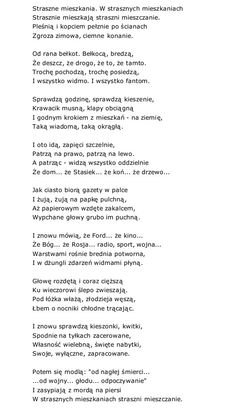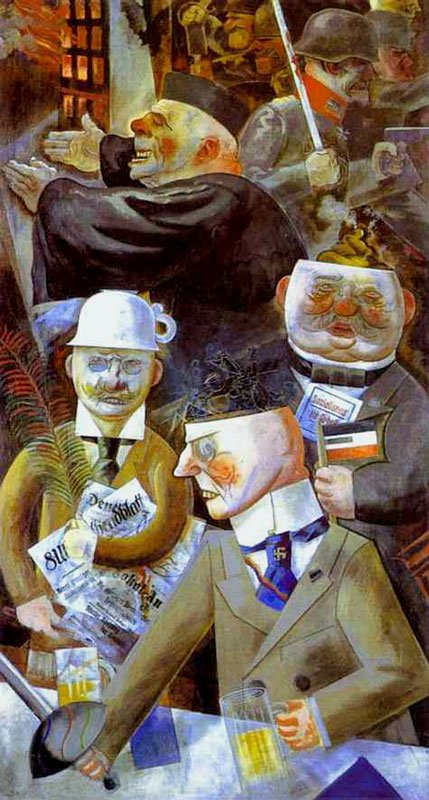I have recently read a poem by Julian Tuwim titled "Residents". My task is to compare it with the selected photo or image that would match this song. I chose the image of George Grosz, "Pillars of Society." I compare both works with myself, I will point out similarities, symbols and my preferences related to individual elements.

J. Tuwim - Residents
Horrible apartment. In terrible apartments
Terrible burghers live terribly.
Mold and kick, dark agony.
Winter horror, dark agony.
Gibbering from the morning. Mumble, raving
That it was raining, that it was expensive, that it was that.
They come a little bit, a bit of sitting,
And everything is ghost. And everything you want.
They will check the time, check their pockets,
The ties are brushed, the covers are sutured
And a dignified step from flats - to the ground,
Such a known, such a round one
And here they go, tighten tightly,
They look to the right, they look to the left.
And looking - they see each separately:
That houses ... that Stasiek ... that a horse ... that a tree ...
Like a cake, they take newspapers in their fingers
And they chew, chew on plump mush,
Until, a paper flatter with a lipstick,
Stuffed heads thickly swell
And again they say that Ford ... that cinema ...
That God ... that Russia ... radio, sport, war ...
Layers grow monstrous scare
And in the jungle of events the ghosts flow.
Head torn and getting heavier
Toward the evening they hang blindly
Under the beds, a thief sniffs,
Heads on cool pots poking.
And again they check pockets, receipts,
Butt-fucked pants,
Reverend property, sacred possessions,
Yours, exclusive, busy
Then they faint ... from sudden death ...
... from war ... hunger ... rest
and they fall asleep with their hands on their breasts
terrible townspeople in terrible apartments
Tuwim's poem describes a typical day of the inhabitants of a certain city. The person speaking in a poem criticizes their behavior. He describes them as "horrible burghers" and their place of residence "in terrible apartments". The lyrical subject in the second and sixth stanza of the work thinks that the inhabitants waste time on nonsensical things by writing, for example, "Mumble, raving, That rain, that it is dear, that that that that. They come a little bit, they're a little bit '. In the next verse, he shows us that the burghers do the same things every day, which are routine for them: "They will check the time, check their pockets, The ties mousy, flap obtuse and dignified with flats - for the winter ...". The author in the fifth verse wrote: "Like a cake, they take newspapers in their fingers and chew, they chew on a plump mush, Until, a paper bloated with a foule, Stuffed heads thickly swell them." It shows how people are gullible and believe everything they tell them. Comparing the newspaper to the cake, he wanted to emphasize that it is something for them that they can not refuse, and reading makes them very happy. In the last stanza he describes them as selfish people praying only for themselves and only in need. You can also read that residents, despite the fact that every day they see people like neighbors, employees can not create any ties between them.

The image of Georg Grosz under the title "Pillars of society" is a reflection of the "terrible inhabitants". In the foreground, we see three men. The first is probably a nationalist if not a chauvinist. It can be recognized by a swastika with a swastika on a tie. He has sabers in his right hand and a pint of beer in his left. Black Knight knocks out of his head holding a copy which probably symbolizes war. There is probably a journalist standing next to him, because he keeps newspapers, a pen and a palm leaf that seems to be in the blood. There is a potty on the head. This figure will probably write what they ask him, whether it is true or a lie, and people will believe it. Behind them, we can most probably see a politician holding the flag of the Second German Reich and a book entitled "Socialism is work". His head evaporates fertilizer which can be literally interpreted as "shit knows." In the picture there is also a priest who stretches out his hands inviting others to him but has his eyes closed and pretends not to see a burning house. At the top there are soldiers who really fight terror as if fighting for their homeland.
Both works are very similar to each other, in each of them appears a few of the same things as: newspapers, war, indifference to others and taking care only of their own needs. Characters depicted in Georg's painting are the same people as in the Tuwim poem. Each of the works is an expression of contempt for people in the world. The author lists their mistakes, which include routine, lack of ideas and higher goals. Both of them wanted to present people as insensitive beings who are interested only in themselves and those who easily surrender to others, believing in everything they say, and telling what saliva will bring to their tongue.
It is sad but true. Unfortunately, people are insensitive to other people, and also too gullible. When they hear something in the news, they consider it a sacred truth. Fortunately, there are still people in the world who care not only for themselves and try to make the world better. Such people include, for example, volunteers. I hope that there will be more and more such good people.